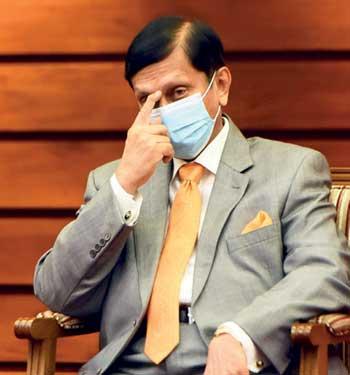Reply To:
Name - Reply Comment
 By Sandun A Jayasekera
By Sandun A Jayasekera
The immediate priority confronting the national economy was to minimize foreign debts, strengthen foreign reserves, create avenues to attract FDI and increase the GDP as the challenges to the country were huge and multifaceted, Central Bank Governor Ajith Nivarrd Cabraal said yesterday.
“The question is whether we are capable of achieving these objectives. My answer is that yes we can,” he added.
Cabraal was speaking at the reception held at the Central Bank auditorium last afternoon to welcome him as the new Governor of the Central Bank for the second time when he made these comments.
“There is no doubt that the situation in the country is extremely critical. But I am not alien to these kinds of affairs. For instance, when I came to the CBSL as the governor for the first time in 2006, we had an economy of US$ 24 billion and the per capita was at US$ 1,242. The foreign debts stood at 2.2 trillion rupees. The COL was double-digit. I was told by certain economic pundits not to make attempts to bring down the COL. However, the CBSL with the timely and pragmatic macroeconomic fundamentals was able to bring down the COL to a single digit, the economy was fattened to US$ 79 billion by 2014 from US$ 24 billion in 2006, per capita rose to US$ 3,854 and the loan ratio was brought down to 71% of the GDP. The foreign reserves rose to US$ 8.2 billion from US$ 4 billion in 2006 in addition to a SWAP arrangement of US$ 2 billion from China. We worked in full confidence up to 2014 encouraged by these positive developments. It was under these economic fundamentals and the strong fiscal position, the then government was able to put an end to the separatist terrorism and bring permanent peace to the country. Therefore, the challenge we have faced today is not something un-surmountable or unachievable,” Cabraal stressed. He lamented that the economy has recorded a downturn since 2015 when the per capita reduced to US$ 3,600 and the debts rose to US$ 16 billion from US$ 7 billion. The rupee has been sharply depreciated and global credit rating agencies have downgraded Sri Lanka with highly negative forecast. That is why Sri Lanka needs a completely new economic outlook and a complete overhaul of its fiscal, economic, and market policies.
Until 2014 we had a road map for our economy. Today also we need a new road map for the national economy to identify our economic priorities and their smooth and target-oriented implementation.
The complete turnaround of the economy with a new and pragmatic approach is not an easy task but it has to be done in the shortest possible time, like two, three, or six months.
To do that we need to think freshly and creatively. When we venture into a new system, new thinking, and new policy measures with a vision to ensure economic and fiscal stabilization, it is natural that we face new challenges. Therefore, we must not only analyze our problems with a free mind but find solutions to them, he emphasized.
We have a plan and a vision for the country with the target of achieving prosperity for all Sri Lankans. The ‘Vistas of Prosperity and Splendor’, the policy framework of President Gotabaya Rajapaksa has shown us the way to accomplish those missions.